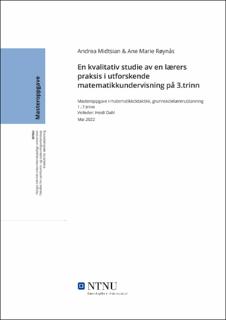| dc.description.abstract | I denne forskningsstudien har vi undersøkt utforskende matematikk i begynneropplæringen. Mer spesifikt har vi sett på hva som kjennetegner en lærers kommunikasjon i utforskende helklassesamtaler og hennes begrunnelser for å drive utforskende matematikkundervisning. Studiens to forskningsspørsmål er på bakgrunn av dette: 1) Hva kjennetegner en lærers kommunikasjon i utforskende helklassesamtaler? og 2) Hvordan begrunner læreren sin positive holdning til utforskende matematikk?
Studien er en kvalitativ enkelcasestudie gjennomført ved bruk observasjon og intervju. For å besvare første forskningsspørsmål observerte vi læreren i en helklassesamtale med fokus på hennes kommunikasjon, mens det påfølgende intervjuet er benyttet for å besvare det andre forskningsspørsmålet. Den utvalgte læreren har lang erfaring med utforskende matematikkundervisning. Hennes arbeid er inspirert av blant andre Catherine Fosnot sitt undervisningsmateriale «context for learning». Datamaterialet tilknyttet det første forskningsspørsmålet ble analysert ved hjelp av tematisk analyse og Ellis, Özgür & Reiten (2019) sitt rammeverk «Teacher moves for supporting student reasoning». Datamaterialet knyttet opp mot det andre forskningsspørsmålet ble analysert ved hjelp av åpen koding. Vi har tatt utgangspunkt i Abril et al. (2013) og PRIMAS sin vide definisjon av «utforskende undervisning», og supplert med annen litteratur som retter seg mer spesifikt mot utforskende matematikkundervisning. Sentrale begreper tilknyttet utforskende matematikkundervisning er språk- og dialog, dybdelæring og sosiomatematiske normer. Teorikapitlet er derfor viet til redegjørelse av disse begrepene.
Studiens resultat viser hvor viktig lærerens kommunikasjonsvalg er for elevers utforskning. Særlig bruk av det Ellis et al. (2019) omtaler som «grep med høyt potensial» ser ut til å være effektivt for støtte av elevers utforskning. Samtidig viser funnene våre at veletablerte sosiomatematiske normer skaper mindre behov for konsekvent bruk av grep med høyt potensial. Likevel er det viktig å påpeke at utelukkende bruk av grep med lavt potensial for støtte av elevers utforskning ligner mer på tradisjonelle kommunikasjonsmønstre, som eksempelvis IRE- og IRF-mønster. I disse er kommunikasjonen preget av læreren ønske å nå læringsmålet for timen, og støtten av elevers utforskning er ineffektiv. Men ser vi på matematikkøkta i sin helhet identifiserer vi at lærerens kommunikasjon i stor grad samsvarer med PRIMAS sin definisjon av «læreren» i utforskende matematikkundervisning. I denne definisjonen står det beskrevet at læreren skal oppmuntre til refleksjon, anerkjenne all deltakelse, stille åpne spørsmål, utfordre elevers løsninger og oppmuntre til gruppe- og helklassesamtaler (Abril et al., 2013), og ifølge den nye læreplanen er dette viktig for elevers dybdelæring (Utdanningsdirektoratet, 2019). Dybdelæring er også sentralt i lærerens begrunnelser for sin positive holdning til utforskende matematikk. Andre begrunnelser hun trekker frem i intervjuet baserer seg på at det er enklere å tilpasse undervisningen til hver enkelt og at skaper bedre grunnlag for god vurdering. | |
| dc.description.abstract | In this study we have examined inquiry-based learning in early childhood education. More specifically, we have focused on a teacher’s communication in whole-class discussions, and her reasons for preferring an inquiry-based approach in her mathematical teaching. Based on this, the study’s two research questions are: 1) What characterizes a teacher’s communication in whole-class discussions in an inquiry-based classroom? and 2) How does the teacher justify her positive view on inquiry-based mathematical learning?
The study is a qualitative case study conducted using qualitative research methods. Observation and interview are the methods we have used for collecting data. To answer our first research question, we observed the teacher in whole-class discussions with focus on her communication. The following interview is mainly used to answer the second research question. The teacher, who is the focus of this study, has long experience with inquiry-based mathematical teaching. Her work is inspired by, among others, Catherine Fosnot’s teaching material «context for learning». The data material associated with the first research question was analysed using an approach referred to as thematic analysis, and Ellis, Özgür & Reiten’s (2019) framework «Teacher moves for supporting student reasoning». The interview related to the second research question was analysed using open coding. We have used Abril et al. (2013) and PRIMAS broad definition of inquiry-based teaching as our general definition, but also supplemented with other literature. Both use of language and dialog for learning, in-depth learning and sociomathematical norm are closely connected to inquiry-based teaching. Therefore, we have devoted space to these topics in the theory chapter.
The result of our study shows how important a teacher's communication is for student inquiry. Especially use of what Ellis et al. (2019) describes as «communication choices with greater potential» seems to be effective in supporting students' inquiry. At the same time, our findings shows that well-established sociomathematical norms lets the teacher be less consistent when it comes to using «communication choices with greater potential». Nevertheless, our findings show that if the teacher only uses communication choices that according to Ellis et al. (2019) has a lower potential for supporting students' inquiry, the communication pattern appears more traditional, such as IRE- and IRF-patterns. In these cases, the support of the student's inquiry is ineffective, and is characterized by the teacher wanting to achieve her learning goal for the lesson. However, if we look at the whole lesson in its entirety, we find that the teachers communication corresponds well with PRIMAS definition of a teacher's role in an inquiry-based teaching. This definition states that the student's inquiry depends on a teacher who encourages reflection, acknowledges all contributions, asks open-ended questions, challenges students' solutions and encourages group and whole-class discussions (Abril et al., 2013), and according to LK20 this is important for students in-depth learning (Utdanningsdirektoratet, 2019). This is also something the teacher mentions in the interview as a positive argument for an inquiry-based teaching. In the interview she also highlights the fact that it is easier to adapt the teaching to each individual student, and that it makes it easier for her to give good assessments. | |
